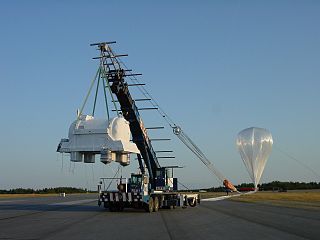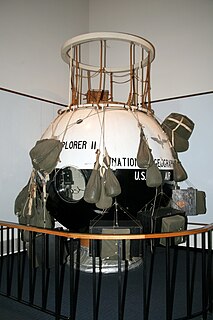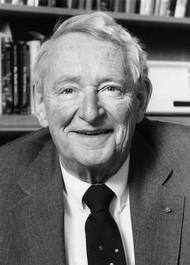
A weather balloon, also known as sounding balloon, is a balloon that carries instruments aloft to send back information on atmospheric pressure, temperature, humidity and wind speed by means of a small, expendable measuring device called a radiosonde. To obtain wind data, they can be tracked by radar, radio direction finding, or navigation systems. Balloons meant to stay at a constant altitude for long periods of time are known as transosondes. Weather balloons that do not carry an instrument pack are used to determine upper-level winds and the height of cloud layers. For such balloons, a theodolite or total station is used to track the balloon's azimuth and elevation, which are then converted to estimated wind speed and direction and/or cloud height, as applicable.

The Swedish Institute of Space Physics is a Swedish government agency. The institute's primary task is to carry out basic research, education and associated observatory activities in space physics, space technology and atmospheric physics.

Vikram Ambalal Sarabhai was an Indian physicist and astronomer who initiated space research and helped develop nuclear power in India. He was honoured with Padma Bhushan in 1966 and the Padma Vibhushan (posthumously) in 1972. He is internationally regarded as the Father of the Indian Space Program.
The Vikram Sarabhai Space Centre (VSSC) is a major space research centre of the Indian Space Research Organisation (ISRO), focusing on rocket and space vehicles for India's satellite programme. It is located in Trivandrum, in the Indian state of Kerala.

Tata Institute of Fundamental Research (TIFR) is a public deemed research university located in Mumbai, India that is dedicated to basic research in mathematics and the sciences. It is a Deemed University and works under the umbrella of the Department of Atomic Energy of the Government of India. It is located at Navy Nagar, Colaba, Mumbai, with an affiliated campus in Serilingampally near Hyderabad. TIFR conducts research primarily in the natural sciences, mathematics, the biological sciences and theoretical computer science.

Skyhook balloons were high-altitude balloons developed by Otto C. Winzen and General Mills, Inc. They were used by the United States Navy Office of Naval Research (ONR) in the late 1940s and 1950s for atmospheric research, especially for constant-level meteorological observations at very high altitudes. Instruments like the Cherenkov detector were first used on Skyhook balloons.

This is a list of meteorology topics. The terms relate to meteorology, the interdisciplinary scientific study of the atmosphere that focuses on weather processes and forecasting.

Research balloons are balloons that are used for scientific research. They are usually unmanned, filled with a lighter-than-air gas like helium, and fly at high altitudes.
The Tel Aviv University Ultraviolet Explorer, or TAUVEX, is a space telescope array conceived by Noah Brosch of Tel Aviv University and designed and constructed in Israel for Tel Aviv University by El-Op, Electro-Optical Industries, Ltd. acting as Prime Contractor, for the exploration of the ultraviolet (UV) sky. TAUVEX was selected in 1988 by the Israel Space Agency (ISA) as its first priority scientific payload. Although originally slated to fly on a national Israeli satellite of the Ofeq series, TAUVEX was shifted in 1991 to fly as part of a Spektr-RG international observatory, a collaboration of many countries with the Soviet Union leading.

Romanian Cosmonautics and Aeronautics Association, also known as ARCAspace, is an aerospace company based in Râmnicu Vâlcea, Romania. It builds rockets, high-altitude balloons, and unmanned aerial vehicles. It was founded in 1999 as a non-governmental organization in Romania by the Romanian engineer Dumitru Popescu and other rocket and aeronautics enthusiasts. Since then, ARCA has launched two stratospheric rockets, four large scale stratospheric balloons including a cluster balloon and was awarded two governmental contracts with the Romanian government and one contract with the European Space Agency. ARCASpace is currently developing a two-stage, semi-reusable steam-powered rocket called EcoRocket.

Malcolm David Ross was a captain in the United States Naval Reserve (USNR), an atmospheric scientist, and a balloonist who set several records for altitude and scientific inquiry, with more than 100 hours flight time in gas balloons by 1961. Along with Lieutenant Commander Victor A. Prather (USN), he set the altitude record for a manned balloon flight.
The Sreenidhi Institute of Science and Technology is a technical institute located in Hyderabad, Telangana, India. It is one of the top colleges in Telangana. The institution is affiliated to the Jawaharlal Nehru Technological University, Hyderabad (JNTUH). In the year 2010-11, the institution attained autonomous status and it is the first college under JNTUH to get that status. The institution is proposed to get Deemed university status from the year 2020-21.

Project Strato-Lab was a high-altitude manned balloon program sponsored by the United States Navy during the 1950s and early 1960s. The Strato-Lab program lifted the first Americans into the upper reaches of the stratosphere since World War II. Project Strato-Lab developed out of the Navy's unmanned balloon program, Project Skyhook. The program was established in 1954 and administrated by Commander Malcolm Ross. Malcolm Ross and others developed the program to accomplish research required for the manned rocket program to follow. This program provided biomedical data that was used for subsequent efforts in space. Malcolm Ross launched five numbered flights as well as other unnumbered flights.

The Stratobowl is a compact natural depression within the limits of Black Hills National Forest in South Dakota, south-west of Rapid City. In 1934–1935 it housed a stratospheric balloon launch site, initially known as Stratocamp, sponsored by the National Geographic Society and the United States Army Air Corps. In 1956–1959 the site was reused by the U.S Navy Project Strato-Lab.

Bharati is a permanent Antarctic research station commissioned by India. It is India's third Antarctic research facility and one of two active Indian research stations, alongside Maitri. India's first committed research facility, Dakshin Gangotri, is being used as a supply base. India has demarcated an area beside Larsemann Hills at 69°S, 76°E for construction. The research station has been operational since 18 March 2012, though it is still being run on trial basis and formal launch is awaited. Since its completion, India has become one of nine nations to have multiple stations within the Antarctic Circle. Bharati's research mandate focuses on oceanographic studies and the phenomenon of continental breakup. It also facilitates research to refine the current understanding of the Indian subcontinent's geological history. News sources have referred to the station variously as "Bharathi", "Bharti" and "Bharati".

Edward Purdy Ney was an American physicist who made major contributions to cosmic ray research, atmospheric physics, heliophysics, and infrared astronomy. He was a discoverer of cosmic ray heavy nuclei and of solar proton events. He pioneered the use of high-altitude balloons for scientific investigations and helped to develop procedures and equipment that underlie modern scientific ballooning. He was one of the first researchers to put experiments aboard spacecraft.
Praful Bhavsar is an Indian space scientist who has held several major positions in the Indian Space program including the Project Scientist for the first rocket launch into space from Indian soil on 21 November 1963. In 1986, he retired from the position of Director, Space Applications Center of the Indian Space Research Organization (ISRO) and the Director, Indian Remote Sensing Satellite Utilization Program.
Badanaval Venkatasubba Sreekantan was an Indian high-energy astrophysicist and a former associate of Homi J. Bhabha at the Tata Institute of Fundamental Research (TIFR). He was also a Dr. S. Radhakrishnan Visiting Professor at the National Institute of Advanced Studies, Bangalore.













